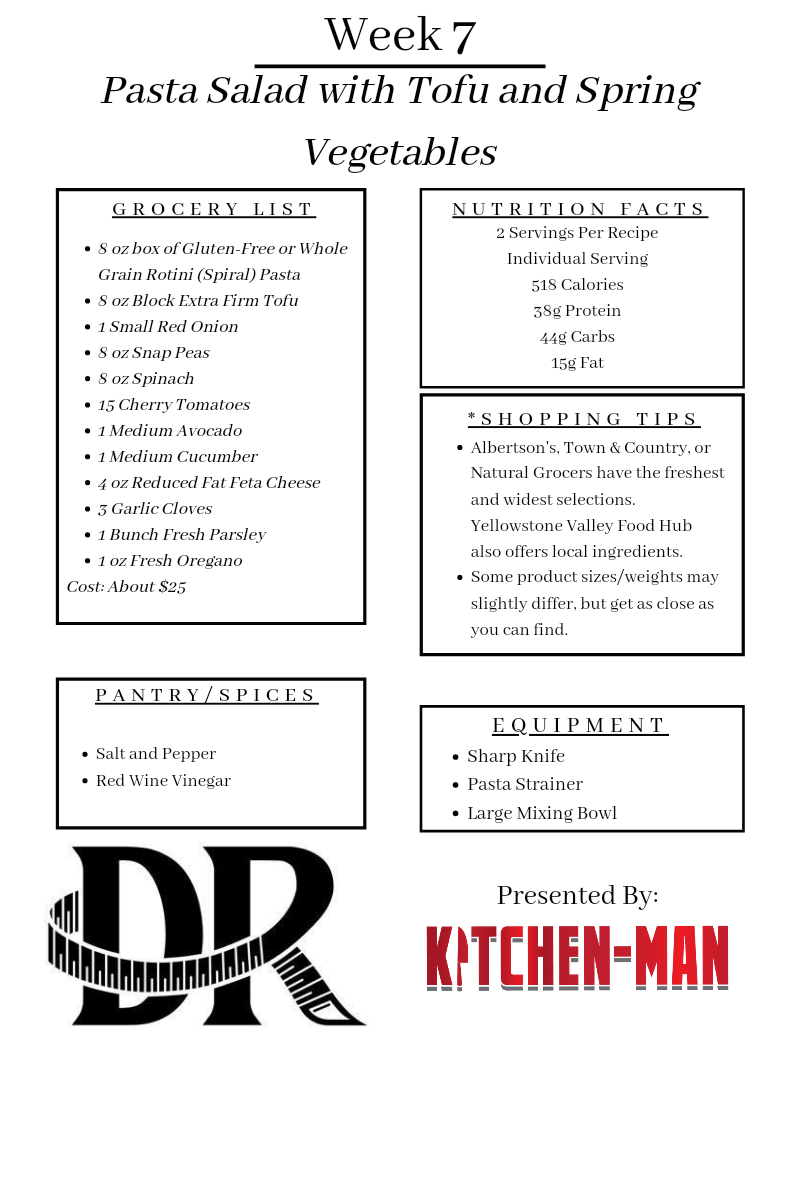Recipes
Pasta Salad with Tofu and Spring Vegetables
18 May 2022


- Start by boiling the pasta, because we want it cooled off when we add it to the vegetables. Bring a medium pot of water to a boil over medium-high heat. Once boiling, add 1 Cup of Rotini Pasta to the water and boil for 6-8 minutes, depending on your preference of texture. 6 minutes will be more al dente and chewy, 8-10 minutes will result in much softer pasta. You can always taste one before straining to find your favorite texture. While this boils, we will start cutting vegetables, so set a timer to remind you about the pasta and remember to stir every minute or 2. Once cooked, pour into a strainer, shake it up to remove any excess water, then add 1 teaspoon of Olive Oil to prevent the pasta from sticking together. Leave in the strainer to cool.
- Next, we will prepare our vegetables. For this, grab a large mixing bowl to add ingredients into once they have been cut. Start by cutting 1 cup of Snap Peas into thirds, or smaller bite-size pieces, then add them to the bowl.
- Cut 15 Cherry Tomatoes in half, then add them to the bowl.
- Slice the ends off of the Red Onion and cut in half through the flat ends. Lay one half of the onion flat, then cut into very thin slices and add it to the bowl. The onion is pretty strong, so you may not need the other half in this recipe. Luckily, onions are great in any recipe, so feel free to save the other half for another meal!
- Remove the ends of the Cucumber, then cut in half lengthwise. Cut the Cucumber into thin, half-moon shaped slices and add to the bowl. Once again, if you have a large Cucumber, you may be able to save the other half as a snack for later.
- Open the package of Extra Firm Tofu, and drain any excess water. Wrap the tofu in a paper towel to absorb any extra moisture. Once it feels dry to the touch, cut the block into small quarter inch cubes. Add 1 cup of tofu cubes to the pasta salad and reserve the rest.
- Remove some of the leaves from the Parsley and roughly chop them into fine pieces. Measure out ¼ cup of chopped Parsley and add to the bowl. Reserve any leftover parsley and place into a plastic bag with a paper towel to preserve freshness in the fridge.
- Roughly chop 2 Tablespoons of Fresh Oregano and add to the bowl. Store the extra Oregano in the fridge.
- Remove the skin from 3 cloves of Garlic and mince by chopping them into very small pieces, then add to the bowl.
- Add ½ cup of Feta Cheese to the bowl.
- Cut the Avocado in half by running your knife through the middle of the top until your knife hits the pit in the middle. Once you feel your knife hit the pit, rotate the Avocado around your knife until you’ve cut all the way through. Grab each half of the Avocado and gently twist until one half separates from the pit. To remove the pit, lightly hit it with the blade of your knife and twist. The pit should stay in the knife blade and then you can discard it. Cut one half of the avocado into cubes by gently running your knife through just the light green part until you feel it hit the inside of the skin. Do this in vertical lines, then horizontal lines. Try not to cut through the skin, because we will scoop the edible portion out with a spoon. Add the first half of diced Avocado to the bowl.
- Now take the other half of the Avocado and scoop it into a separate, smaller bowl. Add 3 Tables spoons of Red Wine Vinegar and 1 teaspoon of salt to the Avocado, then mash it up with a fork until it resembles loose guacamole. If it seems too thick, add another splash of Vinegar or even some Lemon Juice. This will be our “sauce” for the pasta salad, also known as Vinaigrette.
- Pour the Pasta from the strainer into the large salad bowl. Use a spoon to gently mix everything up, then add the Avocado Vinaigrette and mix until incorporated.
- Now, simply add a scoop or two to a bowl and enjoy!
Bonus Tip: If you noticed, we have quite a bit of leftover veggies and ingredients. This is very common when preparing smaller portions of meals, because we often don’t need an entire onion or 30 tomatoes. The challenge of any chef or home cook is to find ways to repurpose these leftover ingredients to create something else instead of throwing them in the trash. Therefore, my test for you this week is to find ingredients in your fridge or pantry and use them to create something new! Good luck, Chefs!